
I occasionally speak out loud to a painting in progress. Usually I ask a question, something like, “What do you want?” Or, if the painting is not responding to my questions, I will utter a frustrated, “Talk to me. Talk to me.” When I behave this way in the studio where I paint with other artists, they are much amused. Once I was introduced to a visitor in the studio by, “This is Dick. He paints abstract acrylics. And he talks to his paintings.” Be careful what you become known for.
There is, however, method to my seeming madness. Many years ago a man who studied linguistics pointed out to me that the subject-verb-object structure of the English language imposed on the consciousness of its user the notion that the subject is in charge. For example, the sentence, “I am making a painting,” suggests that the painting is a passive recipient of my artistic ministrations, that I am in charge, the boss of the proceedings, the one who knows what is needed and how to do it. Those of us who speak English (and many other languages as well) think that way about a lot of things. The subject-verb-object structure is an invitation for ego – the big “I” – to join in whatever we are doing.
My linguistics mentor also told me that there were other language structures. For example, he said that in the language of the Native American Hopi there was no way to say, “I am making a painting.” In Hopi, I was told, the construction would be something like, “The painting is making.” In that way of thinking, I am an instrument of the painting’s making itself rather than its author. This is a whole different brand of consciousness from the one I habitually inhabit.
That brand of consciousness is attractive to me because my best paintings come from a mental space where “I” don’t seem to matter, where I am not “self” conscious. In that space there is little or none of the sense that, “I am making a painting.” Direction seems to come from someplace that is not me. I cannot say where that direction comes from. Does the painting “speak” to me? Does some muse whisper in my ear when “I” resigns from its lofty position? The answers to questions such as those seem beyond my understanding, and I am not sure that the answers even matter so long as I know how to get into and inhabit that very liberating space for a while.
So when I ask a painting, “What do you want?”, or otherwise speak to it, I am trying to shift my consciousness into that space. When the shift occurs, the paintings really do seem to paint themselves.
_____________________________________
The painting shown here is Mushin #3. Details at Mushin #3